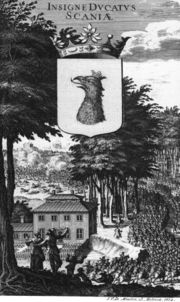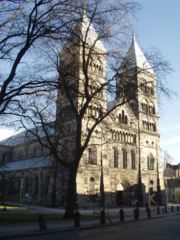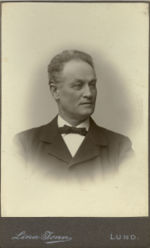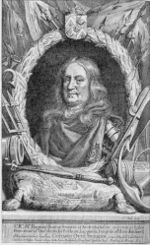Skåneland
2007 Schools Wikipedia Selection. Related subjects: General history
- This region should not be confused with Skånland in Norway.
Halland Skåne Blekinge |
|
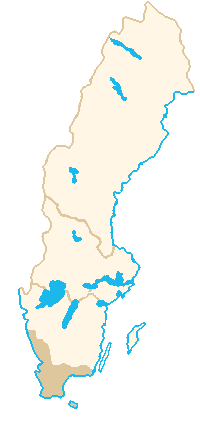 Sweden, with the three Skåneland provinces in brown and the Danish island Bornholm. |
|
 Unofficial flag of Skåneland, only used in the province of Skåne. |
Skåneland or Scania is a denomination for the historical region in southern and southwestern Sweden, once making up the eastern part of Denmark. It was permanently ceded to Sweden under the Treaty of Roskilde ( 1658). Another name for it is Skånelandskapen, which translates to the Provinces of Skåne; sometimes the Latin names terra Scania or terra Scaniæ are used.
Skåneland consists of the provinces Skåne, Halland, and Blekinge. Sometimes, the term only refers to Skåne. The area is almost coterminous with Eastern Denmark, except that the islands of Bornholm and Anholt have remained Danish. Skåneland borders the provinces of Västergötland and Småland. In some rare contexts, this region has been referred to as "Southern Götaland". The region is accepted by the Unrepresented Nations and Peoples Organisation under the name of Scania, although this is also the Latin and English name for Skåne proper.
Official status
Skåneland is the Swedish equivalent to the Danish term Skånelandene, a term used in official contexts in Denmark. In Sweden, the term is seldom used in official context. Because some regionalists advocate independence for Scania proper, or a Swedish republic where regions like Skåneland have more autonomy, the term is unpopular with many Swedes. Such separatist movements often have a basis in nationalism; frequently a sense of political under-representation and a perception of economic disadvantage play important roles. The relatively long amalgamation of Skåneland with Sweden would suggest that the area is generally "Swedified" and that separatism represents a minority viewpoint.
When defining the region in a more general context, the names of the individual provinces are used, or Skåneland is simply considered as being a late addition to the historic Götaland. As such, some contexts have used the term "Southern Götaland" (Södra Götaland).
Origin of name
The Swedish term "Skåneland" was introduced by the Swedish historian and Scandinavist Martin Weibull in his political appeal Samlingar till Skånes historia in 1868 to illuminate the common pre-Swedish history of Skåne, Blekinge, and Halland. The term was basically a translation from the medieval Latin terra Scaniæ ("land of Skåne"). Weibull used the term as a combined term for the three provinces where Skånelagen ("The Scanian law", the oldest provincial law of the Nordic countries) had its jurisdiction, as well as the area of the archdiocese of Lund until the Reformation in 1536, later the Danish Lutheran diocese of Lund. This form of Skåneland was then used in the regional historical periodical Historisk tidskrift för Skåneland, beginning in 1901, published by Martin's son, Lauritz Weibull.
History
Early history
The Latin name terra Scaniæ was used in the Middle Ages as a denomination for the easternmost parts of Denmark. At that time, dense forests and boggy ground blocked the southern provinces of Sweden from Skåneland, in comparison to the relative ease of travel by sea. It was therefore natural to draw the national borders on land. This is documented by Adam of Bremen in the 11th century when he visited Scania and Scandinavia and called it the richest and most important part of Denmark. Even in later periods as the roads gradually improved, some parts were still difficult to travel through, even through the 19th century. From 1104 the Danish archbishop had his residence in Lund; and it was also here the first Danish university was founded, the Lund Academy (1425-1536).
The earliest Danish historians, writing in the 12th and 13th century, believed that the Danish Kingdom had existed since king Dan, in a distant past. Eighth century sources mention the existence of Denmark as a kingdom. According to ninth century Frankish sources, by the early 9th century many of the chieftains in the south of Scandinavia acknowledged Danish kings as their overlords, though kingdom(s) were very loose confederations of lords until the last couple medieval centuries saw some increased centralization. The west and south coast of modern Sweden was so effectively under Danish control that the said area (and not the today Denmark) was known as "Denmark" (literally the frontier of the Daner).
In the loose conditions of medieval kingdom-building, some historians have argued that in 10th and 11th centuries, Scania was more or sometimes attached to the Swedish kingdom instead of the Danish, and that Svend Estridsen and his dynasty were the ones to establish Scania as an integral, and sometimes the more important, part of Denmark - king Svend seems to have been from Scania himself.
In 1330s-1360s, Scania was held, even as the "third kingdom", by Magnus VII of Norway and Sweden, as result of temporary dossolution of Danish central government. He was, since 1335, titled "rex Suecie, Norwegie et Scanie" or "regnorum svechie et norwegie terreque scanie rex".
From the Kalmar Union to Denmark's Loss of Skåne, Blekinge and Halland
By the end of the fourteenth century, the Finnish coast was under Swedish control, but Denmark was the most powerful of Scandinavian states. As a result, when the Kalmar Union was formed in 1397, the union was administered from Copenhagen. By 1471 Sweden had tired of Danish domination and rebelled under Sture family leadership. In 1503, when Sten Sture the Elder died, eastern Sweden’s independence from Denmark had been established.
In 1600 Denmark controlled virtually all land bordering on the Skagerrak, Kattegat, and the restricted Sound ( Øresund). The current Swedish provinces of Skåne, Blekinge and Halland were still Danish and the province of Båhuslen was still Norwegian. Skåneland became the site of bitter battles, especially in the 16th and 17th century, as Denmark and Sweden confronted each other for control of the Baltic and of Swedish access to western trade. Danish historians often represent this as a period of unending Swedish aggression during which Sweden was continuously at war, while Swedish historians often represent this as "Sweden's Age of Greatness".
Sweden interevend in the Danish civil war known as the Count's Feud (1534-1536), launching a highly destructive invasion of Skåneland as the ally of King Christian III. Subsequently, in the period between the breakup of the Kalmar Union and 1814, Denmark and Sweden fought 11 times in Skåneland and other border provinces: 1563-70, 1611-1613, 1644-1645, 1657-1658; 1659-1661, 1674-1678, 1700, 1710-1721, 1788, 1808-1809, and 1814.
- During the Northern Seven Years' War, attacks were launched on Sweden from Danish Halland in 1563, and Swedish counterattacks were launched against Danish provinces of Halland and Skåne in 1565 and 1569. In 1570 peace was finally agreed when the Swedish king withdrew the claims to Danish Skåne, Halland, Blekinge and Gotland, while the Danes withdrew their claims to Sweden as a whole.
- During the Thirty Years' War extensive combat took place in the Danish provinces of Skåne, Halland, and Blekinge. By the Peace of Brömsebro ( 1645) Denmark ceded the Norwegian provinces of Jämtland and Härjedalen and agreed Sweden was to occupy the Danish province of Halland for 30 years as a guarantee of the treaty provisions.
- During what has been described as the Northern War ( 1655– 1658), Danish attempts to recover control of Halland ended in a serious defeat administered by Sweden. As a result, in the Treaty of Roskilde ( 1658) Denmark ceded the provinces of Skåne, Blekinge and Halland (i.e., Skåneland).
Vilhelm Moberg, in his history of the Swedish people, provides a thoughtful discussion of the atrocities which were committed by both sides in the struggle over the border provinces, and identified them as the source of propaganda to inflame the peoples’ passions to continue the struggle. These lopsided representations were incorporated into history text books on the respective sides. As an example, Moberg compares the history texts he grew up with in Sweden which represented the Swedish soldier as ever pure and honorable to a letter written by Gustavus Adolphus celebrating the 24 Skånian parishes he’d helped level by fire, with the troops encouraged to rape and murder the population at will. One must infer that this Swedish behaviour was mirrored equally on the Danish side. Skåneland was a rather unpleasant place to dwell for an extended period.
Assimilation with Sweden
Following on the Treaty of Roskilde in 1658 - but in direct contradiction of its terms - the Swedish government forcefully demanded Skåneland adopt Swedish customs and laws. Swedish became the only permitted language in the Church liturgy and in schools, books in Danish were not allowed to be printed, and all appointed politicians and priests were required to be Swedish. To promote further Swedish assimilation the University of Lund was inaugurated in 1666, and the inhabitants of Scania were not allowed to enroll in Copenhagen University until the 19th century.
The population was initially opposed to the Swedish reforms, as can be ascertained from church records and court transcripts. The Swedes did encounter severe civil revolts in some areas, perhaps most notably in the Göinge district, in dense forest regions, and in northern Scania. Against 17th Century rebels known as " snapphanar", the Swedish authorities resorted to the use of impalement, where the stake was inserted between the spine and the skin of the victim. In that way, it could take four to five days before the victim died.
The last civil revolts in Skåneland were peasant revolts early in the 19th century, but during that period the region was so integrated that, at the end of the century, Skåneland was declared to have been "fully incorporated with Swedish habits, customs and history".
The transformation of age-old customs, commerce and administration to the Swedish model could not be effected quickly or easily. In the first fifty years of the transition, the treatment of the population was rather ruthless, but thereafter it softened. Denmark, on the other hand, made several attempts to recapture the territories -- the last attempt in 1710, during which they almost recaptured the entire Skåneland until they were beaten back by Swedish armies and forced to withdraw.
Recent history
The complete history of Skåneland was not taught for a long time in schools in Skåneland, especially during periods with the immediate threat of revolt. Instead a Swedish-centric history was taught, and the Scanian history before 1658, for instance concerning the list of monarchs, was disregarded as a component of Danish history. In reaction, a movement began in the late 19th century to revive awareness of the history and culture of Skåneland. The renewed focus resulted in the publication of several books about Scanian history.
It is still disputed whether children of the Scanian Provinces should learn the local Danish-era history or the Swedish history for the period before 1658.
Administration
Before 1658, Skåneland had consisted of four counties: the counties of Malmöhus, Landskrona, Helsingborg and Kristianstad.
When the area was annexed by Sweden, Blekinge County was merged with Kristianstad County, to form at total of three counties of the area. In addition, Sweden also appointed a Governor General, who in addition of having the highest authority of the government, also was the highest military officer. The first to hold the post of Governor General was Gustaf Otto Stenbock, between 1658 to 1664. His residence was in the largest city, Malmö.
The office of Governor General was abandoned in 1669, deemed unnecessary. However, when the Scanian War erupted in 1675, the office was reinstated, and Fabian von Fersen held the office between 1675 to 1677, when he died in the defence of Malmö.
Replacing him was Rutger von Ascheberg, in 1680. He came to hold it to his death in 1693. It was during Ascheberg's time in office that the stricter policy of Swedenfication was initiated, as a reaction to the threats of war and possible Danish repossession.
Following the death of Ascheberg, the Governor General was dismantled into separate generals, governing the separate provinces Skåne, Blekinge and Halland.
Sources: Terra Scania website
Modern usage
The term Skåneland (Scania) is today mostly used to denote the area accepted as an unrepresented nation and in order to differentiate it from the historical, pre-1658 Skåne proper (Scania), the now Swedish province Skåne (Scania) and from the administrative county Skåne (Scania), a county recently established after having been split into Malmöhus County and Kristianstad County between 1719 and 1997. Skåneland is based on the Danish term Skånelandene, a term of historical significance as a common name for Bornholm and the formerly Danish, now Swedish, provinces of Skåne, Blekinge and Halland. It is a term which translates to "Terra Scaniae" in Latin, the term preferred in medieval times. Both terms were in use after the area became Swedish, as noted by the Swedish Academy, which lists examples of the usage of Skåneland in documents from 1719, from 1759 (by Carl von Linné), from 1901 and from 1937. In some examples of Swedish usage, Bornholm is not included. The collective term for the provinces is presently not in general use among Swedish historians or in government administration. The modern usage is therefore mostly found in research by Danish and regional historians as a way to refer to the common culture, language and history of Skåne, Blekinge, Halland and Bornholm before the Swedish acquisition of Skåne, Blekinge and Halland, and by regionalists who desire to stress the culturally unique features of the region. In regards to the usage of the term regionalist in this context, it is worth noting that the term is sometimes used in a liberal way to encompass all historians who view the two kingdoms' violent and brutal tug of war over the area as a footnote in the history of the region, and not the other way around.
Because of the revived notions of a common cultural heritage, separate from that of the national state of Sweden, Skåneland has become a member of UNPO (Unrepresented Nations and Peoples Organisation) and FUEN (Federal Union of European Nationalities) under the name of Scania.
